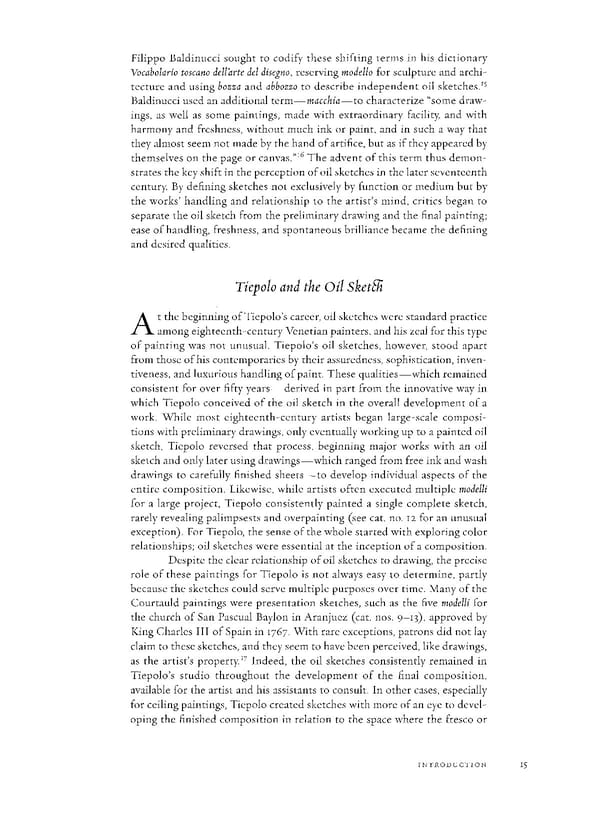Filippo Baldinucci sought to codify these shifting terms in his dictionary Vocabolario toscano dell'arte del disegno, reserving modello for sculpture and archi- 15 tecture and using bozza and abbozzo to describe independent oil sketches. Baldinucci used an additional term—macchia—to characterize "some draw- ings, as well as some paintings, made with extraordinary facility, and with harmony and freshness, without much ink or paint, and in such a way that they almost seem not made by the hand of artifice, but as if they appeared by 516 themselves on the page or canvas/ The advent of this term thus demon- strates the key shift in the perception of oil sketches in the later seventeenth century. By defining sketches not exclusively by function or medium but by the works' handling and relationship to the artist's mind, critics began to separate the oil sketch from the preliminary drawing and the final painting; ease of handling, freshness, and spontaneous brilliance became the defining and desired qualities. Tiepolo and the Oil Skettfi At the beginning of Tiepolo's career, oil sketches were standard practice among eighteenth-century Venetian painters, and his zeal for this type of painting was not unusual. Tiepolo's oil sketches, however, stood apart from those of his contemporaries by their assuredness, sophistication, inven- tiveness, and luxurious handling of paint. These qualities—which remained consistent for over fifty years — derived in part from the innovative way in which Tiepolo conceived of the oil sketch in the overall development of a work. While most eighteenth-century artists began large-scale composi- tions with preliminary drawings, only eventually working up to a painted oil sketch, Tiepolo reversed that process, beginning major works with an oil sketch and only later using drawings—which ranged from free ink and wash drawings to carefully finished sheets—to develop individual aspects of the entire composition. Likewise, while artists often executed multiple modelli for a large project, Tiepolo consistently painted a single complete sketch, rarely revealing palimpsests and overpainting (see cat. no. 12 for an unusual exception). For Tiepolo, the sense of the whole started with exploring color relationships; oil sketches were essential at the inception of a composition. Despite the clear relationship of oil sketches to drawing, the precise role of these paintings for Tiepolo is not always easy to determine, partly because the sketches could serve multiple purposes over time. Many of the Courtauld paintings were presentation sketches, such as the five modelli for the church of San Pascual Baylon in Aranjuez (cat. nos. 9—13), approved by King Charles III of Spain in 1767. With rare exceptions, patrons did not lay claim to these sketches, and they seem to have been perceived, like drawings, as the artist's property.17 Indeed, the oil sketches consistently remained in Tiepolo's studio throughout the development of the final composition, available for the artist and his assistants to consult. In other cases, especially for ceiling paintings, Tiepolo created sketches with more of an eye to devel- oping the finished composition in relation to the space where the fresco or INTRODUCTION 15
 Giambattista Tiepolo: Fifteen Oil Sketches Page 15 Page 17
Giambattista Tiepolo: Fifteen Oil Sketches Page 15 Page 17